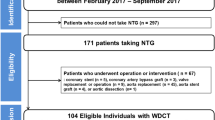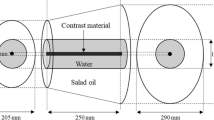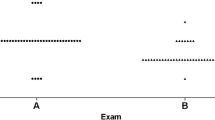Abstract
The aim of the study was to implement an abdominal CT angiography protocol using 100 kVp and to compare SNR and CNR, as well as subjective image quality, to a standard CT angiography protocol using 120 kVp on a 16 detector-row CT scanner. Forty-eight patients were referred for routine abdominal CT angiography on a 16 detector-row CT scanner. Patients were scanned using either 120 or 100 kVp at constant mAs settings. Vessel opacification was provided by automated contrast injection using similar injection protocols. Density measurements were performed along the aorto-iliac axis with SNR and CNR calculation. In addition, the estimated effective patient radiation dose was calculated. Results of both protocols were compared. The 100-kVp protocol (432±80 HU) showed a significantly higher vessel density than the 120-kVp (333±90 HU; P<0.001) protocol, corresponding to an average increase in signal intensity of 30.7%. SNR (36.0 vs 37.0) and CNR (31.1 vs 31.7) for the 100-kV protocol were not significantly lower that those for the standard protocol (P=0.79 and P=0.87), whilst the average estimated dose was significantly lower using the 100-kVp protocol (6.7±0.4 vs 10.1±1.2 mSv; P<0.0001). Tube kVp reduction from 120 to 100 kVp allows for significant reduction of patient dose in abdominal CT angiography, without significant change in SNR,CNR and image quality.




Similar content being viewed by others
References
Rubin GD, Schmidt AJ, Logan LJ, Sofilos MC (2001) Multi-detector row CT angiography of lower extremity arterial inflow and runoff: initial experience. Radiology 221:146–158
Rubin GD, Shiau MC, Leung AN, Kee ST, Logan LJ, Sofilos MC (2000) Aorta and iliac arteries: single versus multiple detector-row helical CT angiography. Radiology 215:670–676
Tanikake M, Shimizu T, Narabayashi I, Matsuki M, Masuda K, Yamamoto K, Uesugi Y, Yoshikawa S (2003) Three-dimensional CT angiography of the hepatic artery: use of multi-detector row helical CT and a contrast agent. Radiology 227:883–889
Schoepf UJ, Holzknecht N, Helmberger TK, Crispin A, Hong C, Becker CR, Reiser MF (2002) Subsegmental pulmonary emboli: improved detection with thin-collimation multi-detector row spiral CT. Radiology 222:483–490
Remy-Jardin M, Tillie-Leblond I, Szapiro D, Ghaye B, Cotte L, Mastora I, Delannoy V, Remy J (2002) CT angiography of pulmonary embolism in patients with underlying respiratory disease: impact of multislice CT on image quality and negative predictive value. Eur Radiol 12:1971–1978
Ofer A, Nitecki SS, Linn S, Epelman M, Fischer D, Karram T, Litmanovich D, Schwartz H, Hoffman A, Engel A (2003) Multidetector CT angiography of peripheral vascular disease: a prospective comparison with intraarterial digital subtraction angiography. AJR Am J Roentgenol 180:719–724
Willmann JK, Mayer D, Banyai M, Desbiolles LM, Verdun FR, Seifert B, Marincek B, Weishaupt D (2003) Evaluation of peripheral arterial bypass grafts with multi-detector row CT angiography: comparison with duplex US and digital subtraction angiography. Radiology 229:465–474
Willmann JK, Wildermuth S, Pfammatter T, Roos JE, Seifert B, Hilfiker PR, Marincek B, Weishaupt D (2003) Aortoiliac and renal arteries: prospective intraindividual comparison of contrast-enhanced three-dimensional MR angiography and multi-detector row CT angiography. Radiology 226:798–811
Brix G, Nagel HD, Stamm G, Veit R, Lechel U, Griebel J, Galanski M (2003) Radiation exposure in multi-slice versus single-slice spiral CT: results of a nationwide survey. Eur Radiol 13:1979–1991
Cohnen M, Poll LJ, Puettmann C, Ewen K, Saleh A, Modder U (2003) Effective doses in standard protocols for multi-slice CT scanning. Eur Radiol 13:1148–1153
Huda W, Scalzetti EM, Levin G (2000) Technique factors and image quality as functions of patient weight at abdominal CT. Radiology 217:430–435
Wintermark M, Maeder P, Verdun FR, Thiran JP, Valley JF, Schnyder P, Meuli R (2000) Using 80 kVp versus 120 kVp in perfusion CT measurement of regional cerebral blood flow. AJNR Am J Neuroradiol 21:1881–1884
Huda W, Ravenel JG, Scalzetti EM (2002) How do radiographic techniques affect image quality and patient doses in CT? Semin Ultrasound CT MR 23:411–422
Bongartz G, Golding SJ, Jurik AG, Leonardi M, van Meerten EVP, Geleijns J, JK A, Panzer W, Shrimpton PC, Tosi G (1999) European guidelines on quality criteria for computed tomography. Report EUR 16262 EN: http://www.drs.dk/guidelines/ct/quality/default.htm, ISBN 92-828-7478-7478
Shope TB, Gagne RM, Johnson GC (1981) A method for describing the doses delivered by transmission X-ray computed tomography. Med Phys 8:488–495
Imhof H, Schibany N, Ba-Ssalamah A, Czerny C, Hojreh A, Kainberger F, Krestan C, Kudler H, Nobauer I, Nowotny R (2003) Spiral CT and radiation dose. Eur J Radiol 47:29–37
Becker CR, Bruening R, Schaetzl M, Schoepf UJ, Reiser MF (1999) Xenon versus ceramics: a comparison of two CT X-ray detector systems. J Comput Assist Tomogr 23:795–799
Kaatee R, Van Leeuwen MS, De Lange EE, Wilting JE, Beek FJ, Beutler JJ, Mali WP (1998) Spiral CT angiography of the renal arteries: should a scan delay based on a test bolus injection or a fixed scan delay be used to obtain maximum enhancement of the vessels? J Comput Assist Tomogr 22:541–547
Awai K, Hiraishi K, Hori S (2004) Effect of contrast material injection duration and rate on aortic peak time and peak enhancement at dynamic CT involving injection protocol with dose tailored to patient weight. Radiology 230:142–150
Ertl-Wagner BB, Hoffmann RT, Bruning R, Herrmann K, Snyder B, Blume JD, Reiser MF (2004) Multi-detector row CT angiography of the brain at various kilovoltage settings. Radiology 231:528–535
Sigal-Cinqualbre AB, Hennequin R, Abada HT, Chen X, Paul JF (2004) Low-kilovoltage multi-detector row chest CT in adults: feasibility and effect on image quality and iodine dose. Radiology 231:169–174
Author information
Authors and Affiliations
Corresponding author
Rights and permissions
About this article
Cite this article
Wintersperger, B., Jakobs, T., Herzog, P. et al. Aorto-iliac multidetector-row CT angiography with low kV settings: improved vessel enhancement and simultaneous reduction of radiation dose. Eur Radiol 15, 334–341 (2005). https://doi.org/10.1007/s00330-004-2575-y
Received:
Revised:
Accepted:
Published:
Issue Date:
DOI: https://doi.org/10.1007/s00330-004-2575-y




